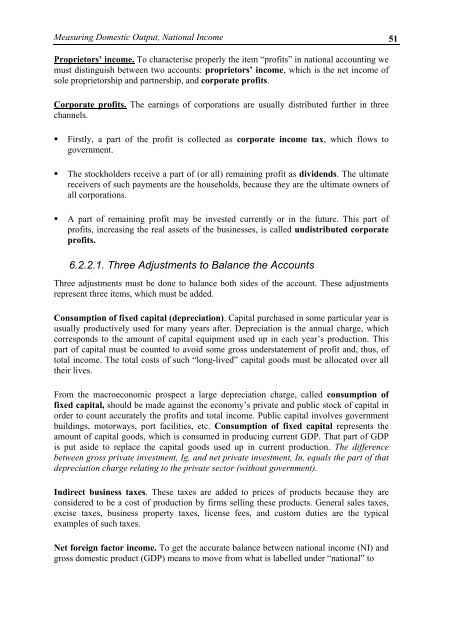MacroeconomicsI_working_version (1)
Create successful ePaper yourself
Turn your PDF publications into a flip-book with our unique Google optimized e-Paper software.
Measuring Domestic Output, National Income 51<br />
Proprietors’ income. To characterise properly the item “profits” in national accounting we<br />
must distinguish between two accounts: proprietors’ income, which is the net income of<br />
sole proprietorship and partnership, and corporate profits.<br />
Corporate profits. The earnings of corporations are usually distributed further in three<br />
channels.<br />
• Firstly, a part of the profit is collected as corporate income tax, which flows to<br />
government.<br />
• The stockholders receive a part of (or all) remaining profit as dividends. The ultimate<br />
receivers of such payments are the households, because they are the ultimate owners of<br />
all corporations.<br />
• A part of remaining profit may be invested currently or in the future. This part of<br />
profits, increasing the real assets of the businesses, is called undistributed corporate<br />
profits.<br />
6.2.2.1. Three Adjustments to Balance the Accounts<br />
Three adjustments must be done to balance both sides of the account. These adjustments<br />
represent three items, which must be added.<br />
Consumption of fixed capital (depreciation). Capital purchased in some particular year is<br />
usually productively used for many years after. Depreciation is the annual charge, which<br />
corresponds to the amount of capital equipment used up in each year’s production. This<br />
part of capital must be counted to avoid some gross understatement of profit and, thus, of<br />
total income. The total costs of such “long-lived” capital goods must be allocated over all<br />
their lives.<br />
From the macroeconomic prospect a large depreciation charge, called consumption of<br />
fixed capital, should be made against the economy’s private and public stock of capital in<br />
order to count accurately the profits and total income. Public capital involves government<br />
buildings, motorways, port facilities, etc. Consumption of fixed capital represents the<br />
amount of capital goods, which is consumed in producing current GDP. That part of GDP<br />
is put aside to replace the capital goods used up in current production. The difference<br />
between gross private investment, Ig, and net private investment, In, equals the part of that<br />
depreciation charge relating to the private sector (without government).<br />
Indirect business taxes. These taxes are added to prices of products because they are<br />
considered to be a cost of production by firms selling these products. General sales taxes,<br />
excise taxes, business property taxes, license fees, and custom duties are the typical<br />
examples of such taxes.<br />
Net foreign factor income. To get the accurate balance between national income (NI) and<br />
gross domestic product (GDP) means to move from what is labelled under “national” to




